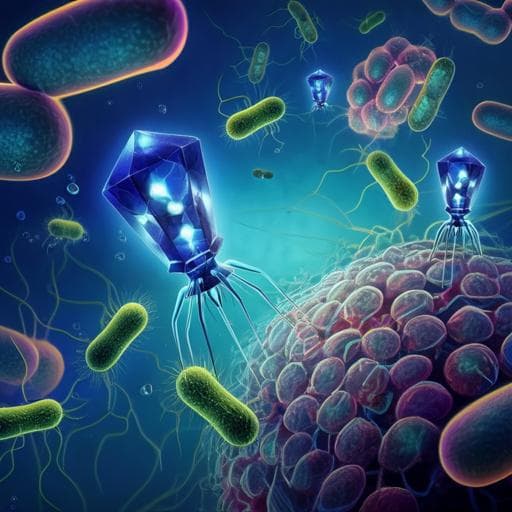
Environmental Studies and Forestry
Virus-pathogen interactions improve water quality along the Middle Route of the South-to-North Water Diversion Canal
T. Chen, T. Liu, et al.
This study reveals an intriguing natural water 'self-purification' process in China's South-to-North Water Diversion Canal, highlighting how virus-pathogen interactions can enhance water quality. conducted by Tianyi Chen, Tang Liu, Zongzhi Wu, Bingxue Wang, Qian Chen, Mi Zhang, Enhang Liang, and Jinren Ni.
~3 min • Beginner • English
Introduction
The study investigates how long-term phosphorus (P) limitation shapes virus–pathogen dynamics and water quality along the 1,432 km Middle Route of the South-to-North Water Diversion Canal (MR-SNWDC) in China. Viral lifecycles (lytic, lysogenic, chronic) depend strongly on nutrient availability, and P scarcity can alter host-virus interactions, potentially regulating pathogen populations. The MR-SNWDC has exhibited sustained, extreme P limitation (TP generally <0.02 mg/L) since 2015. The research question asks whether P-limited conditions favor viral strategies that suppress bacterial pathogens and thereby contribute to natural water self-purification. Using metagenomics across seasons and space, the authors aim to profile viral and bacterial community distributions, identify environmental drivers (especially P), examine viral and pathogen ecophysiology under P starvation, and evaluate health risk implications for downstream water-receiving areas.
Literature Review
Background literature highlights: (1) nutrient limitation concepts including Liebig’s law and oligotrophic thresholds for TP and TN, and the use of N:P stoichiometry (e.g., Redfield 16:1) to infer limitation; P-limited ecosystems often exhibit elevated N:P ratios (>20:1 in freshwaters; higher in many rivers and lakes). (2) P is essential for ATP, nucleic acids, and phospholipids; P scarcity disrupts membrane biogenesis, DNA replication, protein synthesis, and can induce cellular stress or apoptosis. (3) Viral ecology frameworks (kill-the-winner vs piggyback-the-winner) link nutrient status and host productivity to lytic vs lysogenic strategies; lysis is often prevalent in oligotrophic systems. (4) Viruses can reprogram host metabolism via auxiliary metabolic genes (AMGs), including genes enhancing P acquisition under P stress. (5) Metagenomics and MAGs enable large-scale pathogen and viral surveillance beyond cultivation or PCR-based methods. This context motivates testing whether P limitation in the MR-SNWDC selects for viral strategies that suppress pathogenic bacteria, improving water quality.
Methodology
Study area and sampling: The MR-SNWDC is a closed, unidirectional flow canal with cement boundaries, minimizing external inputs. Historic TP (2015–2021) was obtained from 32 monitoring stations. Dedicated campaigns sampled the same 32 sites in August 2020 (autumn) and March 2021 (spring), collecting >30 L water per site, filtered through 0.22 μm membranes within 24 h. Environmental variables measured per standards (GB3838-2002) included pH, EC, turbidity, temperature, F−, SO4 2−, TOC, DOC, CODMn, NH4+-N, NO3−-N, TN, TP, and calculated N:P (molar TN:TP). Cumulative dendritic distance between sites quantified longitudinal position.
DNA extraction and sequencing: Total DNA extracted (FastDNA Spin Kit for Soil), quantified (TBS-380), purity assessed (NanoDrop), and integrity checked (agarose gel). Libraries prepared (NEXTFLEX Rapid DNA-Seq) and sequenced on Illumina NovaSeq 6000, 150 bp PE.
Read QC and assembly: TrimGalore v0.6.4 via metaWRAP; assembly by MEGAHIT v1.1.3 (min contig 1,500 bp).
MAG recovery and taxonomy: Binning using metaWRAP (metabat2, maxbin2, concoct) with refinement; MAG selection thresholds: completeness >70%, contamination <10% (also parallel analyses with HQ MAGs: >90% completeness, <5% contamination). Taxonomy via GTDB-Tk (GTDB r202).
Virus identification and vOTU catalog: Viral contigs predicted by viralVerify, VIBRANT, DeepVirFinder (score >0.85, p<0.05), PPR-Meta, VirSorter2; quality assessed by CheckV. Proviral host regions removed. Viral contig selection: low/medium quality (<90% complete) ≥5 kb, or high-quality/complete (≥90%). Dereplication/clustering at 95% ANI using CD-HIT to define nonredundant vOTUs. Taxonomy by geNomad; lifestyles of HQ/complete vOTUs predicted by BACPHLIP.
Abundance profiling: Reads mapped with Bowtie2 to MAGs and vOTUs; coverage via CoverM (RPKM; identity ≥95%; aligned percent ≥90%).
Virus–host prediction: Three in silico methods combined—nucleotide homology (BLASTn, ≥90% identity, e≤0.001), tRNA matches (ARAGORN; BLASTn 100% identity and coverage), and CRISPR spacer matches (minced; BLASTn ≤1 mismatch, 100% coverage). Linkages cross-checked against Virus-Host DB to remove taxonomically inconsistent pairs; unclassified virus–host pairs retained when not contradicted. Co-occurrence network construction described in Supplemental Methods.
Resistome/virulence and pathogen definition: ORFs from MAGs aligned to SARG v2.2 (ARGs) and VFDB (VFGs) via BLASTP (identity ≥80%, coverage ≥80%, e≤1e−5). MAGs with VFGs designated potential pathogens; those with VFGs and ≥10 ARGs designated super pathogens.
Functional annotation and normalization: Proteins annotated via eggNOG-mapper (eggNOG v5.0, DIAMOND). AMG prediction/validation detailed in Supplemental Methods. Average copy number per gene normalized by the mean counts of 10 universal single-copy genes (COG0012, COG0016, COG0018, COG0172, COG0215, COG0495, COG0525, COG0533, COG0541, COG0552).
Comparative viral genomics: Complete viral genomes (>5 kb, 100% completeness) from MR-SNWDC compared to IMG/VR viruses from wastewater, marine, lake, and river ecosystems (n=22,387). Assessed genome size, CDS counts, GC content, amino acid composition using Kruskal–Wallis and Bonferroni-corrected Wilcoxon tests.
Statistics: R 4.1.1 with α=0.05. NMDS on Bray–Curtis dissimilarities (vOTUs and MAGs); PERMANOVA for spatiotemporal differences; geographic PCNMs from dendritic distances; partial Mantel tests for environment–community correlations; random forest with permutation importance (rfPermute) to rank environmental drivers; co-occurrence networks (Spearman ρ≥0.7, Bonferroni p<0.05) linking environmental gradients and taxa. Defined regional growth factor (RGF) to classify MAG dynamics (emerged, promoted, inhibited, vanished) relative to Reg 1 (source).
Key Findings
- Extreme and persistent P limitation: Seven-year monitoring showed TP nearly always <0.02 mg/L (Class I), with annual averages 2019–2021 at ~0.006–0.007 mg/L. N:P ratios were extremely high (~350:1 on average; 290:1–405:1 sustained over years). TP declined longitudinally from ~0.010–0.011 mg/L (source) to ~0.004–0.005 mg/L (downstream) (autumn R²=0.46; spring R²=0.56).
- Community structure and drivers: 40,261 vOTUs (average length 16.4 kb; mostly dsDNA) and 4,443 MAGs recovered from 64 samples. Viral and bacterial communities partitioned into four ecological regions along the canal. Partial Mantel tests and random forests identified TP (and N:P) as dominant drivers of both viral and bacterial community variation, with TP ranking most important in both seasons.
- Viral genomic adaptation to P scarcity: Among 646 complete MR-SNWDC viral genomes, mean genome size was ~25 kb, significantly smaller than viruses from P-richer ecosystems, notably wastewater (~47 kb). Reduced encoding of functions for replication/recombination/repair and posttranslational modification contributed to compact genomes. MR-SNWDC viruses had higher GC content and amino acid composition indicative of enhanced structural stability (e.g., lower Lys/Arg ratio, higher Pro), consistent with a “self-conservation” strategy under P stress.
- Bacterial repression under P limitation: Bacterial richness decreased downstream; in autumn, 2,109 source MAGs were reduced by ~50% by the canal end. P-acquisition and P-based functional genes declined in normalized copy number with distance, including pstS and phoH (R²=0.39, p<0.0001), PPP genes G6PD/6PGD (R²=0.32, p<0.0001), phospholipid biosynthesis genes plsX/plsY (R²=0.46, p<0.0001), and RNR genes (R²≈0.30, p<0.0001). Broader metabolic functions (carbohydrate, energy, nitrogen, sulfur, nucleotide metabolism) also declined.
- Virus–host dynamics: 11.6% of vOTUs linked to hosts (33,391 virus–host pairs) across 15 bacterial phyla, dominated by Actinobacteriota (35.6%) and Proteobacteria (33.9%). ~90% of high-quality/complete viruses predicted lytic. Virus–host abundance ratios increased downstream (autumn R²=0.14, p<0.05; spring R²=0.28, p<0.01), indicating enhanced infection pressure. Virus-encoded RNR abundance increased downstream (autumn R²=0.16, p<0.05; spring R²=0.44, p<0.0001), consistent with boosted viral DNA replication. Virus AMGs included pstS (P acquisition) and nucleotide metabolism genes (DUT, DNMT, dcd, thyA) and galE, supporting host metabolic reprogramming during infection.
- Pathogen recession and reduced risk: Pathogens detected at source (Reg 1) numbered 387 (autumn) and 292 (spring), ~15.3% of MAGs, but declined downstream. External inputs caused slight increases in Reg 2, yet vanished pathogen counts in Reg 4 were ~10-fold higher than in Reg 2. Ten ARG-rich “super pathogens” appeared upstream but were nearly eliminated by Reg 4. Virus–pathogen abundance ratios increased with distance (autumn R²=0.12, p<0.05; spring R²=0.25, p<0.01). Overall, viral predation under P limitation reduced waterborne pathogens by over 30% and nearly eliminated super pathogens downstream, lowering health risks.
Discussion
The findings support the hypothesis that extreme P limitation in the MR-SNWDC promotes viral strategies (primarily lytic infections with enhanced RNR-mediated replication) that suppress bacterial pathogens, resulting in a natural self-purification effect. P scarcity constrains pathogen fitness by impairing core P-dependent processes (P acquisition, membrane formation, nucleotide biosynthesis via PPP and RNR), while viruses adopt compact, stable genomes and leverage host-derived P and energy through infection, aided by AMGs to augment nucleotide production. Increased virus–host and virus–pathogen abundance ratios downstream, coupled with rising virus-encoded RNR abundance, indicate stronger top-down control of pathogens where P is scarcest. This dynamic reduces pathogen loads (including antibiotic-resistant super pathogens) toward water-receiving areas, improving drinking water safety. The study highlights the interplay of bottom-up (P limitation) and top-down (viral predation) forces in shaping pathogen ecology and suggests that virus-mediated nutrient shunting and P recycling may help sustain viral communities and further moderate bacterial populations under severe P constraints. These insights emphasize ecological controls that can be leveraged in sustainable water resource management.
Conclusion
This work reveals a natural analogue of bacteriophage therapy operating at ecosystem scale: under persistent and extreme P limitation (TP <0.02 mg/L; N:P ~290–405:1), indigenous viruses in the MR-SNWDC adopt compact, structurally robust genomes and enhance lytic infection cycles (with elevated RNR abundance), while P-starved bacterial pathogens lose key functional capacities and decline downstream. Consequently, pathogen loads drop by over 30% and antibiotic-resistant super pathogens are nearly eliminated in water-receiving areas, indicating reduced health risks. The study identifies P limitation as the primary environmental driver of viral–bacterial dynamics in this system and demonstrates a self-purification pathway that can inform drinking water protection and sustainable water management. Future work should quantify virus-mediated P shunt contributions to nutrient cycling, incorporate longer time-series to resolve seasonal dynamics, and refine models linking nutrient stoichiometry, viral lifestyles, and pathogen risk.
Limitations
- Temporal resolution: Only two seasonal sampling points (autumn 2020, spring 2021) were available; authors note that more time-series data (N>2) are needed to robustly assess seasonality of viral communities.
- Quantification of viral shunt: The study infers potential P recycling via viral lysis but states that quantitative estimates require more comprehensive P data and rigorous biophysical models.
- Genome quality and assembly: A large fraction of viral genomes are low/medium quality due to short-read assembly challenges and novelty of environmental viruses, potentially limiting complete functional resolution.
- In silico host prediction: Although validated against Virus-Host DB and multiple methods (homology, tRNA, CRISPR) were combined, computational predictions can include uncertainties, especially for unclassified viruses and hosts.
- System context: While the canal is relatively closed, flood season inputs can introduce external microbes, complicating strict attribution of all downstream dynamics to upstream sources and in-canal processes.
Related Publications
Explore these studies to deepen your understanding of the subject.







